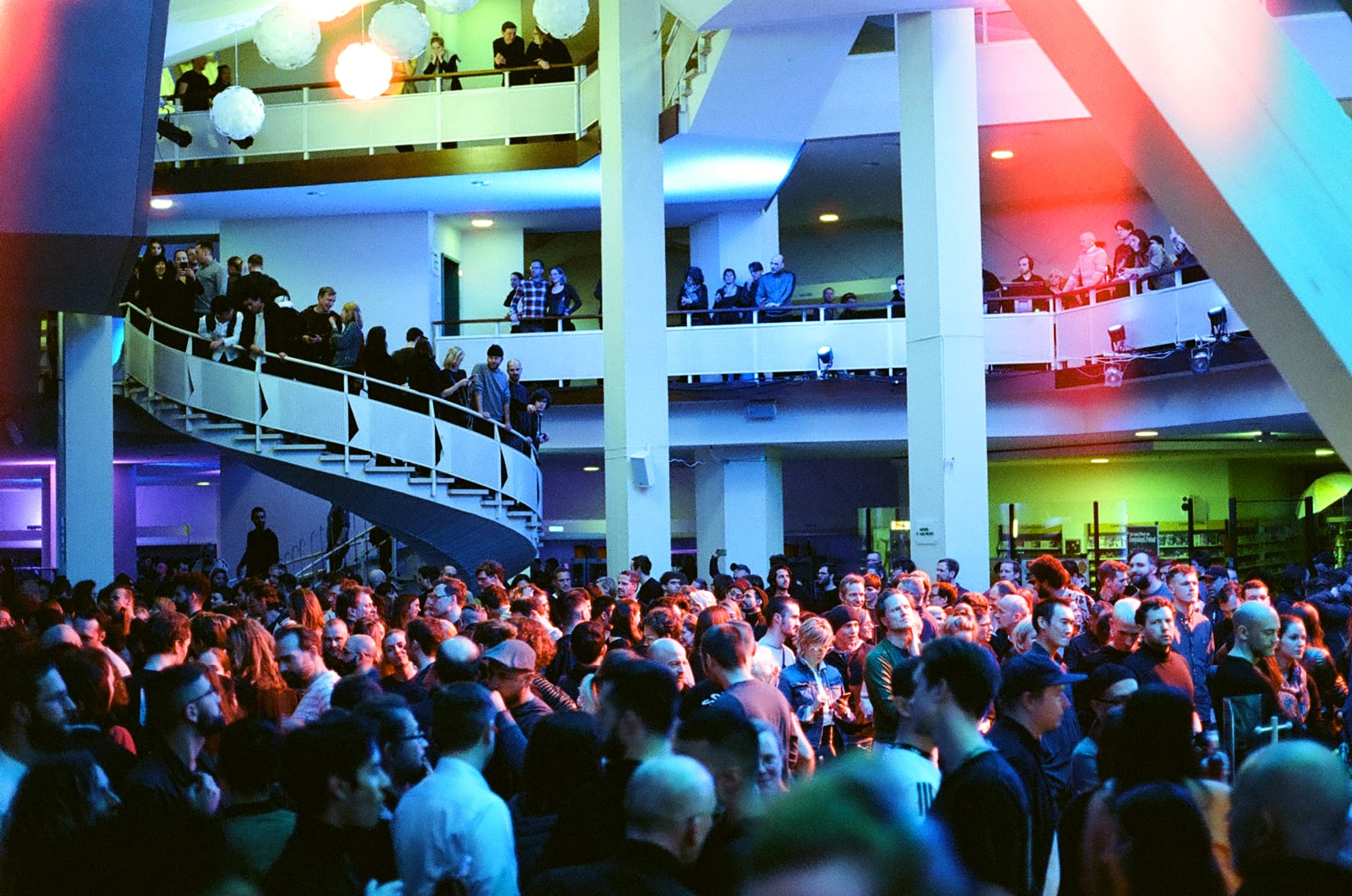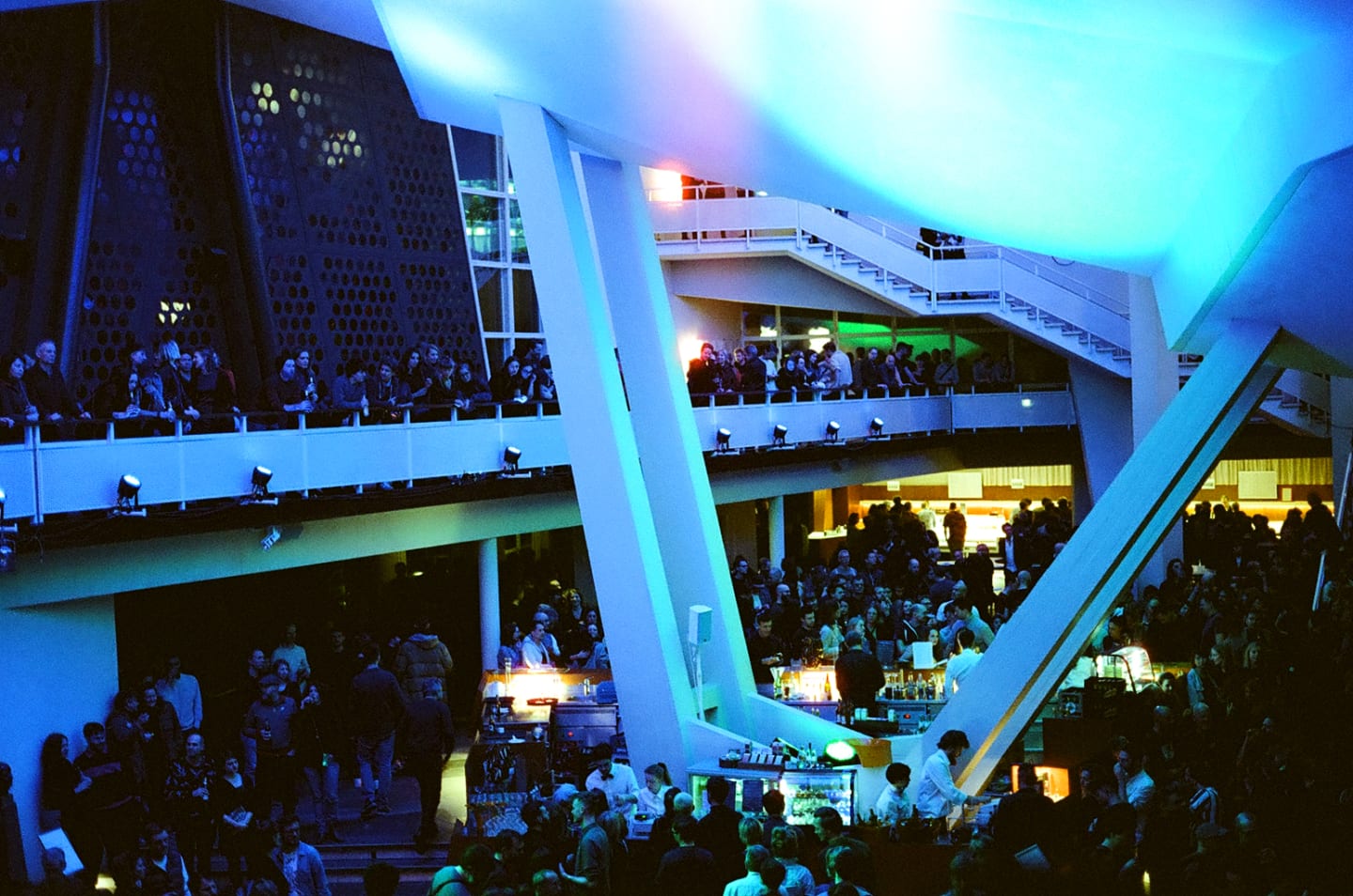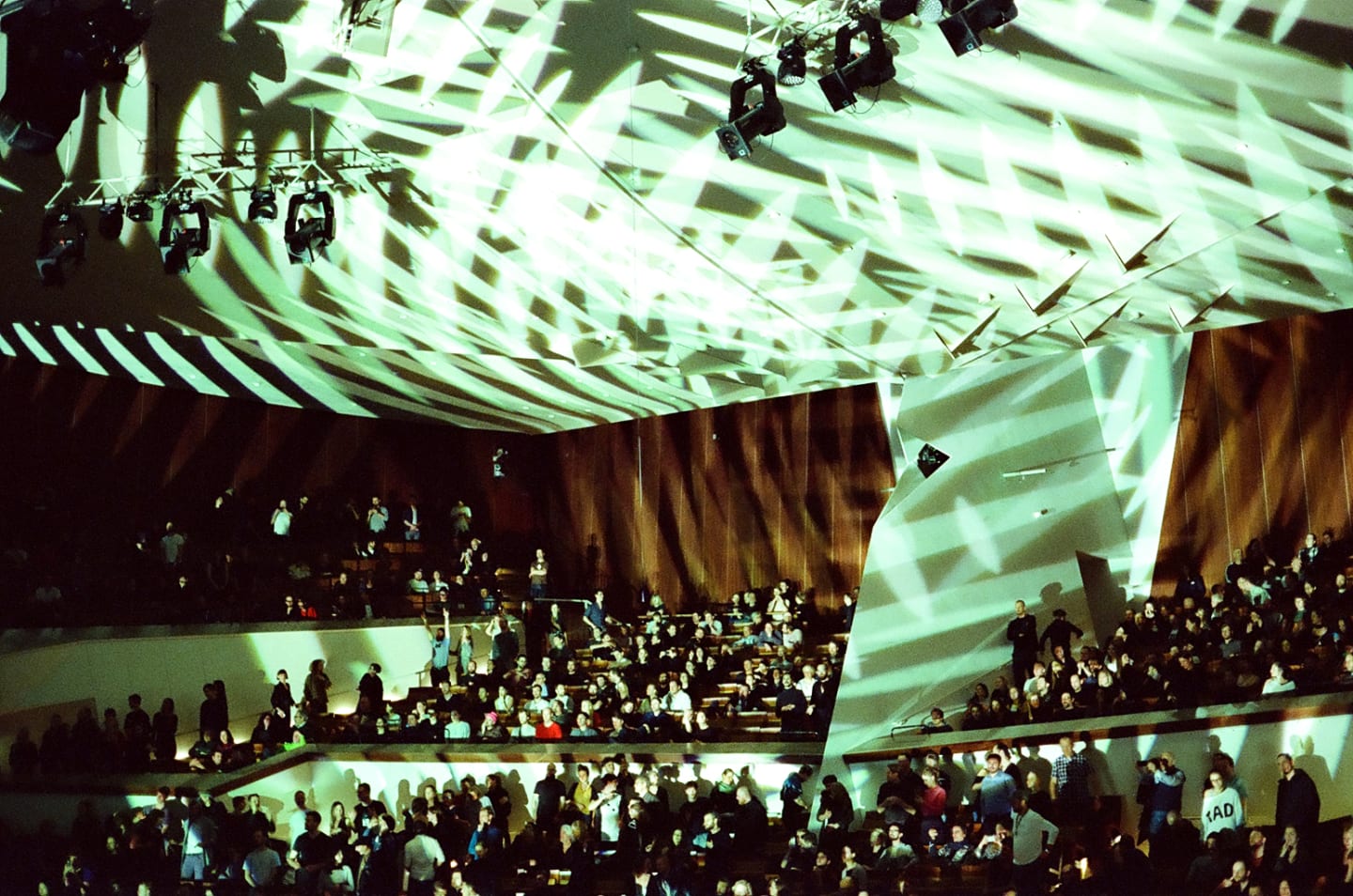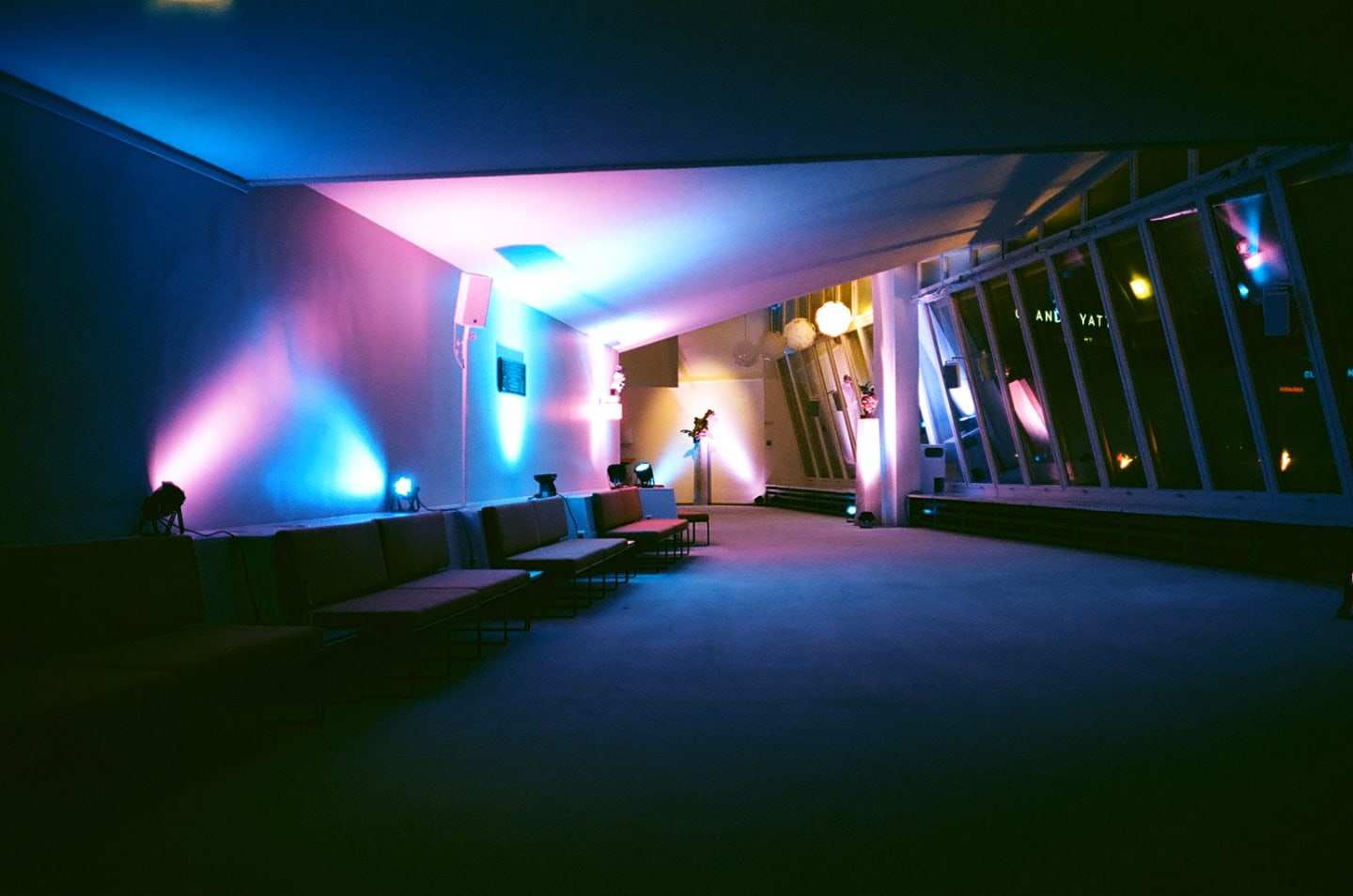
An Interview With Stefan Goldmann on His Berlin Philharmonie Techno Takeover
The Strom Festival curator bridges the divide between high cultural institutions and electronic music
The term “electro-acoustic doesn’t limit your imagination the way ‘ambient’ or ‘experimental’ do,” states Stefan Goldmann. Working in between the dancefloor and high art institutions, the techno renaissance man toes the line between revering club music’s history and fearlessly pushing its forms into the future.
Goldmann is equally comfortable DJing and releasing his own productions on imprints like Perlon, Ovum, Innervisions, Mule Electronic and his own Macro label, which he co-founded with Finn Johanssen in 2007, as he is lecturing in universities and penning the 2015 book on electronic music aesthetics, Presets – Digital Shortcuts to Sound. He’s also concieved of the legendary Elektroakustischer Salon at Berghain, a space which explores a more boundless approach to electronic music and has become a fixture in the experimental electronic scene. As Goldmann puts it, “The music presented there tends to follow its own rules.”
Goldmann’s interdisciplinary approach to composition, production, and presentation has led him to compose and perform site-specific concerts at Kyoto’s Honen-In Temple, the Los Angeles County Museum of Art and the Centro Cultural Kirchner Buenos Aires. Tailored to the spatial conditions, these performances provide a unique, irreproducible listening experience—one that breaks the listener out of passive listening habits.
With his expansive work as music scholar and techno producer, he was an obvious front runner to curate Strom, the first ever festival for electronic music that took place in the venerable Berlin Philharmonie this past weekend February 7th and 8th. In the venue’s pentagonal Grand Hall designed by German architect Hans Scharoun, pioneering artists like Kruder & Dorfmeister, Cristian Vogel, and Ryoji Ikeda performed live, while Deena Abdelwahed, KiNK, and Nina Kraviz played out under the futuristic archways in the foyer. After the landmark event, we asked Goldmann to dig deeper into the potential for cementing electronic music into time-honoured music institutions and traditions.

Electro-acoustic
performance and composition plays an integral part in your work. What about it
particularly fascinates you?
Part of the fascination is in freeing yourself from meeting
external needs, like making music danceable or beat-matchable by DJs. Dance
music producers sometimes mute the beat to check how other elements sound on
their own, zooming in and working on details. But then most unmute the drums
again, so you don’t get to experience this outside the studio. From time to
time, I opt to keep the beat muted and let those other layers blossom on their
own.
What are some pivotal
moments that opened that whole sphere up for you?
A lot of 1990s drum’n’bass had fantastic sounds underneath the drums which I kept noticing. People like Matrix, Optical, and Source Direct wrote stunning intros but rarely bothered developing these parts into their own forms.
Later, I discovered techno in which the bass drum was more of a
reference than a dominant sound—or it was missing altogether. Jeff Mills’ Axis
stuff, Plastikman’s Consumed,
Wolfgang Voigt’s work and Mika Vainio’s albums Onko and Oleva were all
eye openers, and I always wanted to travel further down this road. Don’t get me
wrong, though; I love beats.
What exactly draws your
interest to commissioned musical pieces as part of art projects in comparison
to your own more club-oriented productions?
I get paid. Jokes aside, ever since I’ve been producing music, I
could have taken any track as a blueprint and rolled out another fifty
“soundalikes”. But if you’ve been making music for a while and don’t want to
get bored, you begin to look left and right.
Now, if you produce music that falls into a functional genre such as techno, there’s usually also an infrastructure in place that brings it to the people. For instance labels, DJs and clubs do that. If your music doesn’t fit there, that infrastructure is missing. Commissions provide open settings where you’re free from formal standards, where you can bring forward other aspects of the music. They provide frameworks for music that doesn’t fit a preconceived form.

In general, there seems
to be an ongoing conversation within experimental electronic and avant-garde
music about its intersection with conceptual art and its presentation in more
“highbrow” environments. Why do you think this is?
I guess highbrow and lowbrow are a misleading pair of terms when we’re talking about music that’s
either electronic or produced predominantly for the recording medium. Historically, the difference between high and low used to be one
of social class. That’s no longer the case. With audio recording, everyone has
equal access to the archives, and it’s up to what people want to pull out that
determines what remains in there. And that often turns out to be something
rather different from what cultural institutions had envisioned.
That might also help explain why aesthetics are spilling over from one set of institutions into another. Clubs, labels, distribution channels and the related press are one set of institutions and concert halls, art colleges and academies are another. There used to be a contemporary continuation of classical music called “new music”, which inhabited these institutions pretty much exclusively as far as contemporary music was concerned. For a while, that new music stayed in lockstep with avant-garde developments in the other arts. Stanley Kubrick used music by György Ligeti in his films, Gerhard Richter did paintings referencing John Cage, Pierre Boulez used lyrics by E.E.Cummings.
This network of mutual referencing has changed entirely with the last couple of generations. There are almost no significant visual artists, writers or playwrights under fifty who’d still consider the folks at the local conservatory as their peers. The institutions grew aware of this shift, and the next thing you knew Kraftwerk was at the MoMA, Tate Modern, Neue Nationalgalerie and the Kremlin. Twenty years ago it seemed highly unlikely that someone like Robert Henke would be a professor of music at a German conservatory, but my guess is we’ll see much more of this rather soon.
What have been standout
projects of that kind for you recently, as someone who is an observer of that
field?
Artists like Robert Henke, Ryoji Ikeda, or Carsten Nicolai have bridged the gap between electronic and academic music for a long time, opening doors for many to follow. There is still very little score-based music for acoustic instruments and synthesis where I think the sum is greater than the parts, but one notable exception is Ryuichi Sakamoto and Alva Noto’s collaboration with Ensemble Modern, utp_.
On the other hand, how
often do you see such concepts failing, and what would be lessons to be drawn
for a project like Strom?
There appears to be an irresistible urge to create fusion.
People want to put a DJ and a drum machine in front of an orchestra. Make people collaborate for the sake of
ticking boxes of how many media formats you can possibly cram into one project. There has been an unabated flow of premieres where two artists
find themselves on stage together so a festival can write the word “premiere”
on its program—while both would do better on their own and on their own terms.
The somewhat radical solution for Strom was to approach the Philharmonie as a space rather than as an occasion to interact
with given cultural content. Electronic music
artists hardly ever get to work with a space like the Philharmonie’s Great
Hall. I find this quite surprising, given that experimental electronic
music festivals and concert halls both exist in Berlin, but they rarely seem to
come together. Instead of handing out commissions for
fusion works, we handed the artists the keys and let them choose how they
wanted to deal with the setting.

There is this
commonplace assumption that the context of creation is essential or at least
influential to the outcome. Regarding your pieces that involve a specific
listening environment, what makes the context so important to the audience’s
experience?
If you view it the
other way around, it would appear rather odd that the same should work equally
well across greatly different settings. Then the question is to what degree you
want to take this into account. Since most of us work in the recording medium
and then try to translate the sound of that entirely artificial space into real
world brick and mortar settings, it’s not most people’s priority to customise
all that much. Just the existence of standard tech riders tells you enough in
this regard.
When I began getting opportunities to do site-specific projects, I might have turned it a bit into a response to the commodification of recordings due to digitization. While most artists I know chased every channel available, throwing away their music in the hope of catching some elusive audience, I felt I needed to give something special to those who bothered showing up at some place to hear me.
That’s a qualitative
approach to presentation that surely requires a high level of dedication.
You can’t invest that amount of time on research and customization when you play 120 gigs a year, so it’s also a matter of priorities. But it felt worth my time to put in the effort. As far as I know, I played the first ever electronic concert at LACMA, and I’ll play the first at the Philharmonie’s Great Hall. I wasn’t the first to play Honen-in, but I had over a month to check out the place and figure out what to do there before performing. On Alif, we had over a year to structure the performance space together with Chiharu Shiota, Samir Odeh-Tamimi and Jeremias Schwarzer. We did two versions: one for Berlin’s Radialsystem, and another for Nuremberg’s St. Lorenz Church. This timespan allowed for an entirely different depth compared to showing up at 6 PM for soundcheck and hitting the stage at 8.
Was there a key
experience that sparked your interest in the connection between music and the
unusual spaces it is presented in?
I had heard that there had been concerts at Honen-in. One day I
rode my bike up there and ended up spending five hours just sitting in the
yard. It was getting dark, and I had planned to ride back because I had no
lights. But the soundscape was changing so rapidly and intriguingly that I
couldn’t get myself to leave. By chance, I met a guy who had been in touch with
some of the artists who played there, and I asked him if he knew who could possibly say if
there’s a chance to do something there. He basically took out
his calendar and was like, “Can you do June 29?” And that was that.
How did you usually
approach these site-specific commissions in the past? What’s the workflow like,
from initial theory to execution?
Looking at the space and taking it from there is definitely the
best approach for me. Some commission requests are all pre-determined for
everything but the space. They’ll say, ”We have composer X’s anniversary, and
we’d like a live remix where you play with the orchestra over a symphony.”
That’s usually where anyone who’s not entirely desperate for work should say
thanks but no thanks.
I like the ones that start with the space rather than with a grand vision of the content. It’s also kind of a cheeky experience, like a child’s dream of sneaking into a museum past closing time and roaming around without supervision. Plus it’s an excuse to do things in the studio that you can’t when you’re producing something Ben Klock’s supposed to play.

In the program details,
it notes the artists you’ve chosen have developed their sounds away from the
scope of Western Europe and North America. Why was this important in your
curation process for the Philharmonie, a distinctly Western venue, to highlight
these talents?
Berlin is a city where, in terms of electronic music, everything
there is to hear has been heard. There’s no need to compete with the city’s
clubs, festivals and other institutions by repeating what they already
represent. Thus the main focus isn’t on some demographic, style or generation
but on doing what I think the venue stands for, which is presenting peak
achievement at the individual level that is also relevant to Berlin.
There are artists with all sorts of backgrounds involved, but
we’ve also been witnessing a shift to where it doesn’t matter where you’re from
anymore. If you wanted to be anybody in drum’n’bass in 1998, you needed to be
in London or Bristol. Now you can come out of Dnipropetrovsk or Kwazulu Natal
or anywhere else and make a really significant contribution to almost any
genre.
I think this is where the world should be headed anyway. Since
electronic music’s production tools have become widely accessible, we see more
and more diverse backgrounds represented now, offering their own takes on a
shared culture. Some of this first generation of artists from places outside of
Western Europe and North America have “matured” to a degree that their
influence has been feeding back into the core, and that’s really good to show here.
This interview has been edited and condensed for clarity. Strom Festival took place at the Berlin Philharmonie this past weekend 07.02–08.02.















Published February 11, 2020. Words by Andreas Richter, photos by Frankie Casillo.
